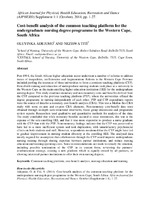| dc.contributor.author | Adejumo, Oluyinka | |
| dc.contributor.author | Titi, Neziswa | |
| dc.date.accessioned | 2017-11-30T16:30:32Z | |
| dc.date.available | 2017-11-30T16:30:32Z | |
| dc.date.issued | 2014 | |
| dc.identifier.citation | Adejumo, O. & Titi, N. Cost-benefit analysis of the common teaching platform for the undergraduate nursing degree programme in the Western Cape, South Africa. African Journal for Physical, Health Education, Recreation and Dance, Supplement 1(1): 1 -27 | en_US |
| dc.identifier.issn | 1117-4315 | |
| dc.identifier.uri | http://hdl.handle.net/10566/3286 | |
| dc.description.abstract | Post-1994, the South African higher education sector underwent a number of reforms to address issues of inequalities, inefficiencies and fragmentation. Reform in the Western Cape Province included pooling the resources of three universities to form a common teaching platform (CTP). Henceforth training and education of undergraduate nursing students took place at a university in the Western Cape as the main enrolling higher education institution (HEI) for the undergraduate nursing degree. This study examines monetary and non-monetary costs and benefits derived from the CTP compared to the previous teaching platform (PTP), where the universities offered the degree programme in nursing independently of each other. PTP and CTP expenditure reports were the source of data for a monetary cost-benefit analysis (CBA). This was a Medias Res CBA study with some ex-ante and ex-post CBA elements. Non-monetary cost-benefit data were obtained through in-depth semi-structured interviews, focus group discussions and programme review reports. Researchers used qualitative and quantitative methods for analysis of the data. The study concluded that while monetary benefits accrued to sister institutions, this was at the expense of the sole enrolling HEI, and that it was more expensive to produce a nurse graduate with the CTP than with the PTP. Non-monetary findings indicate that the CTP was perceived to have led to a more inefficient system and task duplication, with unsatisfactory psychosocial effects on both students and staff. However, respondents mentioned that the CTP might have led to gradual improvement in nursing student diversity at the enrolling HEI. The analysed data mostly negated the assumption that collaboration through the CTP would improve undergraduate nursing training through sharing expertise between partner institutions, and reduce nursing education and training operating costs. Some recommendations are made to remedy the situation, including possible termination of the CTP in its current form, reviewing the partners’ reimbursement strategy, creating a new platform which is equally owned by all partners, or allowing interested partner institutions to offer their own nursing degrees. | en_US |
| dc.language.iso | en | en_US |
| dc.publisher | LAM Publications Limited | en_US |
| dc.rights | Copyright LAM Publications Limited. Publisher granted permission for inclusion of the published file in the Repository. | |
| dc.subject | Common teaching platform | en_US |
| dc.subject | Cost-benefit analysis | en_US |
| dc.subject | Nursing education | en_US |
| dc.subject | Training | en_US |
| dc.title | Cost-benefit analysis of the common teaching platform for the undergraduate nursing degree programme in the Western Cape, South Africa | en_US |
| dc.type | Article | en_US |
| dc.privacy.showsubmitter | FALSE | |
| dc.status.ispeerreviewed | TRUE | |

